Over the course of two days, April 2 and 3, 2016, visitors will have the opportunity to explore 41 gardens throughout Los Angeles County that are opening their gates for the Theodore Payne Foundation’s annual Native Plant Garden Tour. Through their use of primarily native California plants, these gardens welcome wildlife, promote the beauty of natural California and work with, rather than against, their environments.
2016 Theodore Payne Native Plant Garden TourLocation: 41 residential gardens and public landscapes in Los Angeles County
When: April 2 and 3, 10 a.m. to 5 p.m.
Cost: $25 to $30. More info
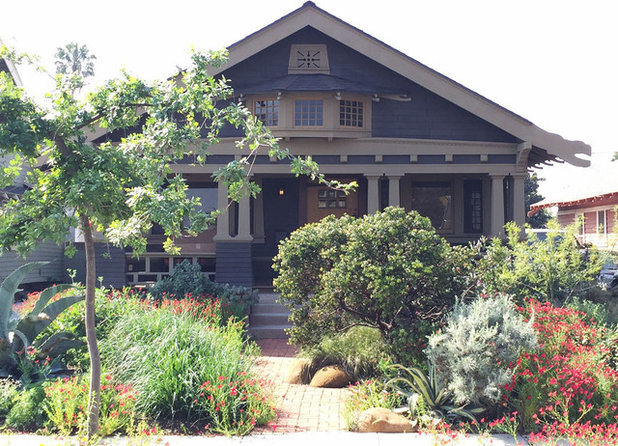 1. Reimagined StreambedLocation:
1. Reimagined StreambedLocation: Jefferson Park neighborhood of Los Angeles
Size: 860 square feet (79.9 square meters)
Designer: Homeowner John Arnold
Plants shown (Click each photo in this story to see the plants tagged): ‘Canyon Prince’ giant wildrye (
Leymus condensatus ‘Canyon Prince’), ‘Sunset’ manzanita (
Arctostaphylos ‘Sunset’), basin big sagebrush (
Artemisia tridentata ssp.
tridentata), deer grass (
Muhlenbergia rigens), valley oak (
Quercus lobata)
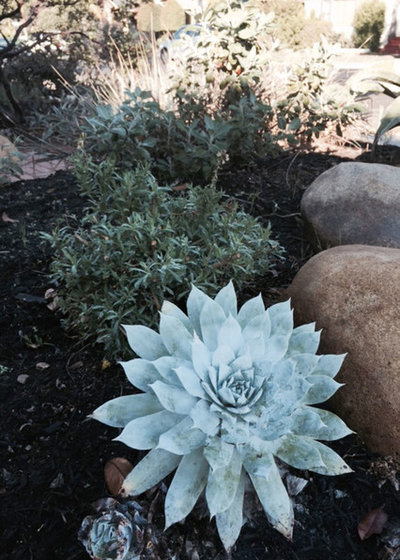
Theodore Payne Foundation
“I lean toward shaggy, casual and naturalistic,” John Arnold says of his front garden’s design. Native shrubs, trees and perennials of Mexico and California are mounded over one another, cascading onto a weathered brick path that meanders from the sidewalk to the front door of the Craftsman home.
The front yard’s design subtly references a streambed, with rocks lining the path as they would a stream, and grasses and shrubs mounded up from brick to higher points in the middle of the planting beds. Arnold also took inspiration from Japanese zigzag bridges when designing his path’s shape.
A lifelong gardener, Arnold has an appreciation of California native plants stemming from when he moved here 17 years ago from the wetter climates of the Pacific Northwest and the East Coast. “I’ve always been conscious of the climate and what it can support,” he says. “Once I started seeing how the ecosystems here work, I really just started paying attention to that cycle.”
Plant shown: Liveforever (
Dudleya sp.)
See more photos and this garden’s complete plant list
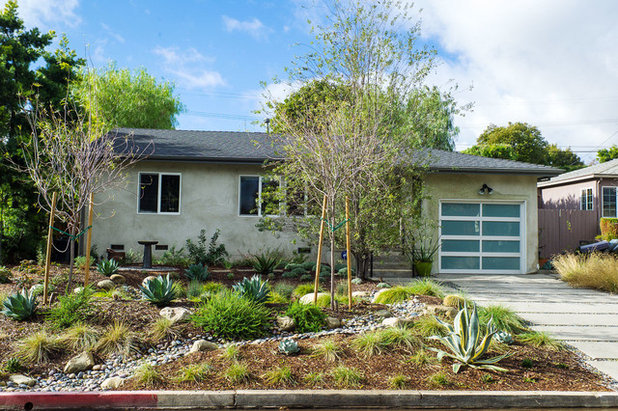
Theodore Payne Foundation
2. Contemporary Rain Garden
Location: Palms neighborhood of Los Angeles
Size: 1,000 square feet (92.9 square meters)
Designer: Tom Rau Landscape Architecture
Bobbie Allen’s nearly 1-year-old front yard not only consumes less water than it did when it was a lawn, it cleans water as well. Landscape architect Tom Rau designed much of the sloping front yard as a basin that captures, cleans and percolates rainwater that drains off Allen’s nearly-2,000-square-foot roof. The first three-quarters of an inch or so of water that falls percolates through the basin, being cleaned by the soil and plants as it replenishes the groundwater. “That’s what they call the first flush,” Rau says. After the first flush, which washes all the dirt and debris off the roof into the garden, clean water overflows the basin and runs along the stone swale into the storm drain at the street.
The plants in and around the basin of the rain garden were selected for their water tolerance, with those in the middle of the basin able to handle both drought and water inundation. Grasses that can handle some water grow on the sides, and purple needle grass (
Stipa pulchra), California’s state grass, grows on top. ‘Timeless Beauty’ desert willows (
Chilopsis linearis ‘Timeless Beauty’) on either side of the basin provide habitat for birds.
Plants shown: ‘Blonde Ambition’ blue grama (
Bouteloua gracilis ‘Blonde Ambition’), ‘Dana Point’ California buckwheat (
Eriogonum fasciculatum ‘Dana Point’), desert agave (
Agave deserti var.
deserti), ‘Timeless Beauty’ desert willow (
Chilopsis linearis ‘Timeless Beauty’), purple needle grass (
Stipa pulchra)
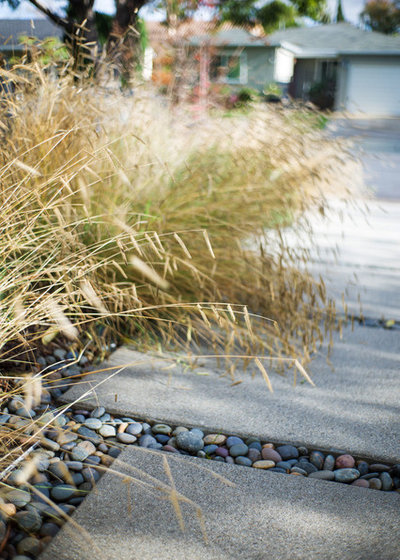
Theodore Payne Foundation
The garden wasn’t designed to resemble a naturally occurring landscape, but the primarily native plant palette has caught the attention of local wildlife. “It has expanded our little universe,” Allen says. “Now I’m responsible for the birds and the butterflies and the squirrels and the possums that are coming to the yard.”
Plant shown: ‘Blonde Ambition’ blue grama (
Bouteloua gracilis ‘Blonde Ambition’)
See more photos and this garden’s complete plant list
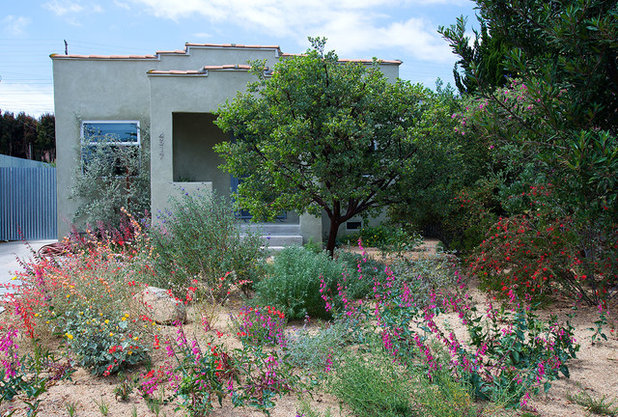
Theodore Payne Foundation
3. Modernist Wildflower MeadowLocation: Del Rey neighborhood of Los Angeles
Size: 900 square feet (83.6 square meters)
Designer: Homeowner J Shields
This compact front yard features a 100 percent native meadow with a modernist twist. Homeowner J Shields and his wife started this garden 21 years ago to create an urban oasis for migratory birds that would also complement their modern aesthetic. Over the years the garden has evolved so that it now also attracts native insects that birds feed on. “Water-saving is great, but it’s secondary to the habitat,” Shields says.
Plants shown: Big berry manzanita (
Arctostaphylos glauca), toyon (
Heteromeles arbutifolia) and a mixture of penstemons, globe mallows and sages
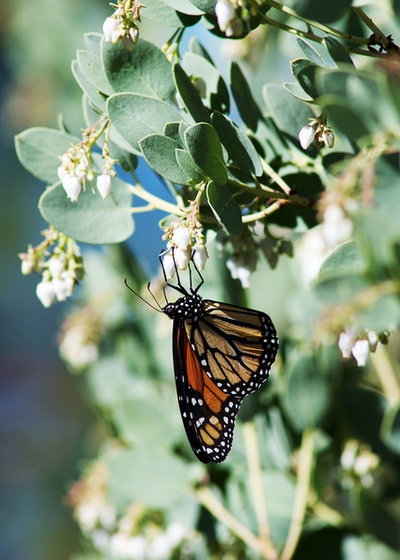
Theodore Payne Foundation
To impose some order on the garden, they chose plants that had known wildlife benefits and that would maintain upright growth habits and stay a reasonable size. “I also planted things that mean things to me,” Shields says. These included plants native to the Channel Islands, because he’s surfed there. The plants all grow through a decomposed granite base that has been installed over the yard’s natural heavy clay soil. “I’ve found that it’s cut down the weeding tremendously,” he says. It also enhances the garden’s modernist aesthetic.
Plant shown: Big berry manzanita (
Arctostaphylos glauca)
See more photos and this garden’s complete plant list
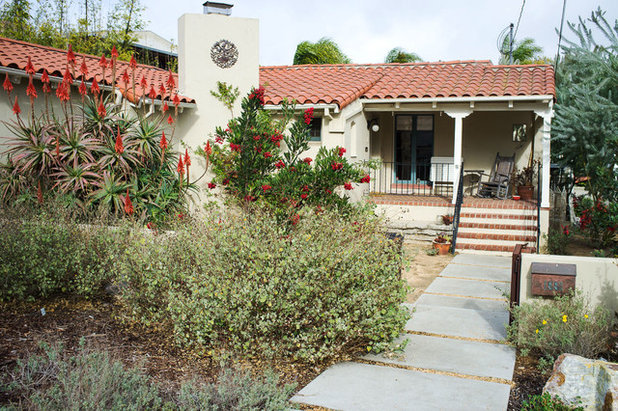
Theodore Payne Foundation
4. Engaging Spanish CourtyardLocation: Manhattan Beach, California
Size: 1,000 square feet (92.9 square meters)
Designer: Oakley Gardens
“We wanted it to be wild but not completely out of control,” homeowner Sarah Olsen says of her home’s new native garden. The designers at Oakley Gardens made this dream a reality by introducing a low wall in the front to create a semiprivate courtyard, a concrete paver walkway to the front door and a courtyard of decomposed granite featuring a somewhat loose planting of California natives. “Very uniform and angular hardscape allows the plants to be really free-form and yet not feel like chaos,” Olsen says.
Plants shown: Toyon (
Heteromeles arbutifolia), Palmer’s Indian mallow (
Abutilon palmeri)
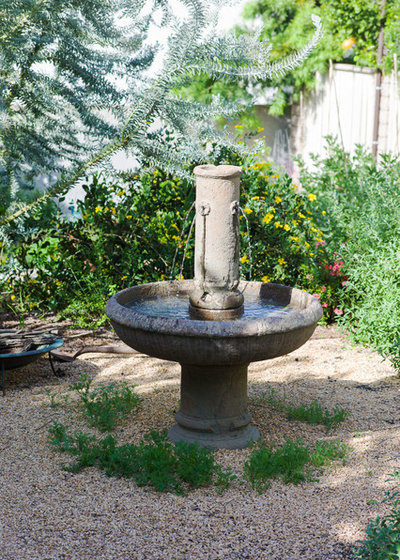
Theodore Payne Foundation
The new front courtyard also creates a feeling of inclusion, both for the homeowners and for passersby. “The garden is completely inviting now,” Olsen says. Cats love it, neighbors love it and even kids who pass by on their way to the nearby school can’t get enough of the landscape. “The neighbor kids love the butterflies and the path,” and like to play on the decomposed granite, Olsen says.
See more photos and this garden’s complete plant list
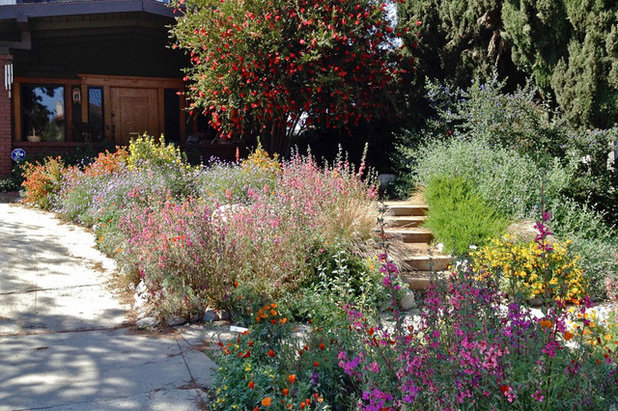
Theodore Payne Foundation
5. Naturalistic Wildflower Meadow
Location: Oxford Square neighborhood of Los Angeles
Size: 1,100 square feet (102.1 square meters)
Designer: Nick Dean Landscape Design
Landscape designer Nick Dean transformed what had been a solid lawn into a billowy wildflower garden. “I wanted it to feel very natural,” Dean says, “like seeds have blown in and landed.” In reality, the planting was a more rigorous task. For the most part he planted in drifts of three, five or seven, with some drifts crossing over the decomposed-granite path for a more windswept look. Scattered wildflower seeds help fill out the planting beds. With the exception of the existing cypress trees and bottlebrush near the front door, all the plants are California natives.
Plants shown: ‘De La Mina’ lilac verbena
(
Verbena lilacina ‘De La Mina’), ‘Jelly Bean Lemon’ monkeyflower, (
Mimulus ‘Jelly Bean Lemon’), compact Cleveland sage (
Salvia clevelandii ‘Compacta’)
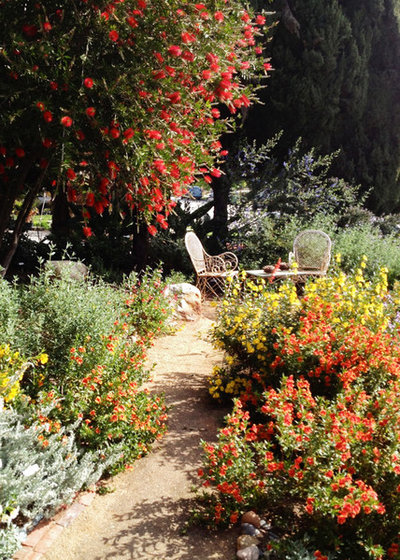
Theodore Payne Foundation
Additionally, the landscape redesign reduced water runoff through a series of terraces that slow the water down and allow it to percolate into the soil. The decomposed-granite path provides garden structure and allows visitors to move through the garden while allowing water to drain. “I don’t want it to be something that you just bypass,” the designer says.
See more photos and this garden’s complete plant list
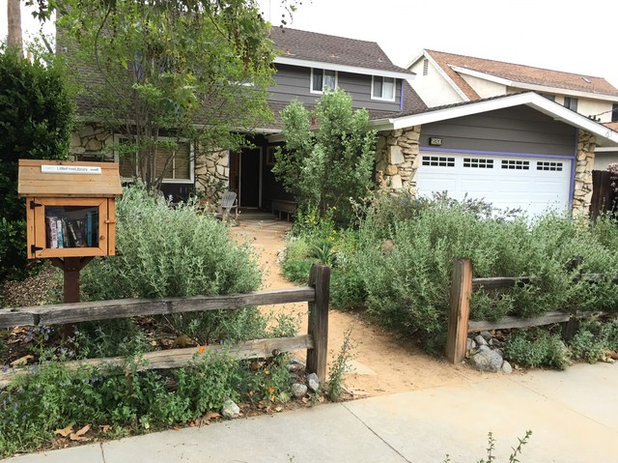 6. Welcoming Woodland
6. Welcoming Woodland
Location: Valley Glen neighborhood of Los Angeles
Size: 1,800 square feet (167.2 square meters)
Designer: Homeowner Jeff Jamison
Four years ago, Jeff Jamison decided to replace his front lawn with a garden that would require less maintenance and be more attractive. “We wanted to make our home and our yard more inviting,” he says. Working with a landscape contractor, Jamison demolished the lawn, added a decomposed-granite path from the sidewalk to the front door and removed the existing concrete path from the driveway to the front door. He used some of the concrete pieces from the demolition in the decomposed-granite walkway to cut costs and add interest.
When it came to planting, Jamison wanted to cut down on water usage and feed the native insects he knew relied on native plants to survive. He planted sages, buckwheats and other more common and easier-to-grow natives on earthen mounds. “We were learning and wanted to have success,” he says.
Shown: ‘Casitas’ Mendocino bushmallow (
Malacothamnus fasciculatus ‘Casitas’), ‘Allen Chickering’ sage (
Salvia ‘Allen Chickering’)
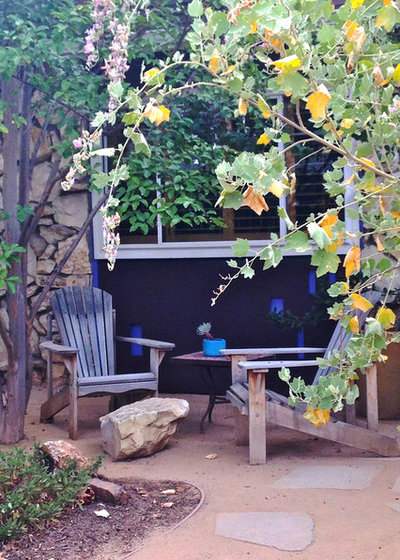
Theodore Payne Foundation
Now, the nearly-95-percent-native garden benefits local wildlife as well as its owners. “Now we want to be out there any chance we get,” Jamison says. “There is something kind of cool about having things from your region.”
See more photos and this garden’s complete plant list
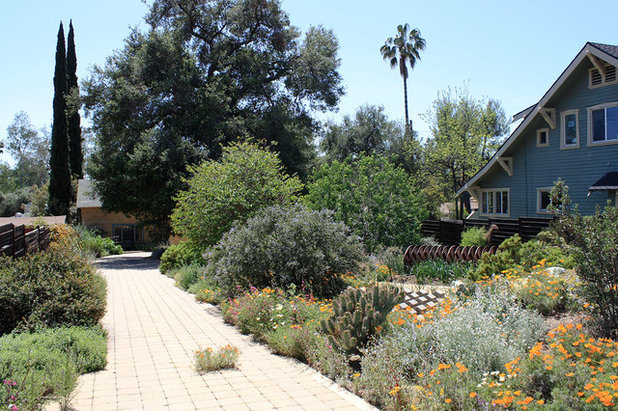
Theodore Payne Foundation
7. Artful Garden With Hidden DiscoveriesLocation: Altadena, California
Size: Runs along a 150-foot-long (45.7-meter) driveway
Designer: Scrub Jay Studios
Homeowner Andreas Hessing’s front garden runs parallel to a roughly 150-foot-long driveway, with a pathway that allows people to stop and take in the splendor of his native garden and the art he’s installed throughout the plantings. “It’s a garden for meandering,” Hessing says. Plants partially obscure the pathway, allowing for moments of surprise and discovery along the way.
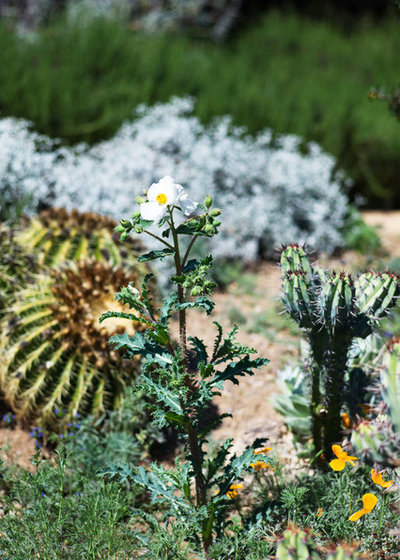
Theodore Payne Foundation
“I wanted something that was completely Californian,” Hessing says of the planting; a variety of native California buckwheats form the base of his planting plan. These low-maintenance, wildlife-friendly plants produce white flowers that turn to a red shrubby brown later in the season, complementing the rusty machine parts he incorporated in the art installation. (You can just see a glimpse of the art in the far-right corner of the previous photo.)
See more photos and this garden’s complete plant list
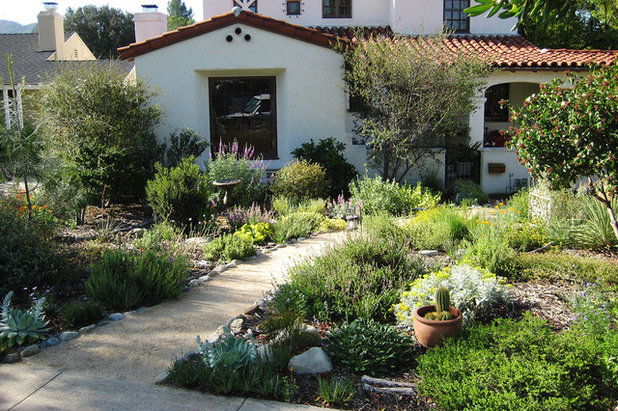
Theodore Payne Foundation
8. Native Garden for Summer BeautyLocation: Glendale, California
Size: 1,100 square feet (102.1 square meters)
Designer: Homeowner Mike Sovich
A meandering path of decomposed granite set amid a bevy of California native plants is a far cry from the landscape Mike Sovich encountered when he moved here in the early 1990s. “It was a typical Bermudagrass front yard,” he says. Having worked in water utility for many years, Sovich was familiar with California’s water shortages and set to work replacing the lawn with low-water plants. “My motivation had been water conservation originally,” he says.
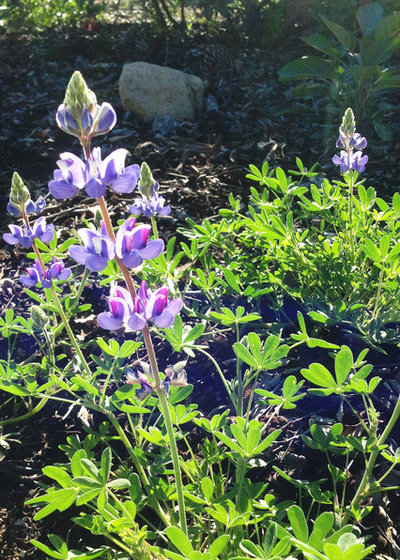
Theodore Payne Foundation
Over the years native plants replaced the nonnative plants, especially ones that looked attractive in the hot summer months. As many California natives experience dormancy over the summer, when many people expect a garden to be at its peak, Sovich filled out the garden with decomposed-granite paths and other garden structures to offset any seasonal downturn. “Plants are very important, and I love the plants, but really what makes the landscape beautiful is the structural bones to it,” he says.
Plant shown: Arroyo lupine (
Lupinus succulentus)
See more photos and this garden’s complete plant list
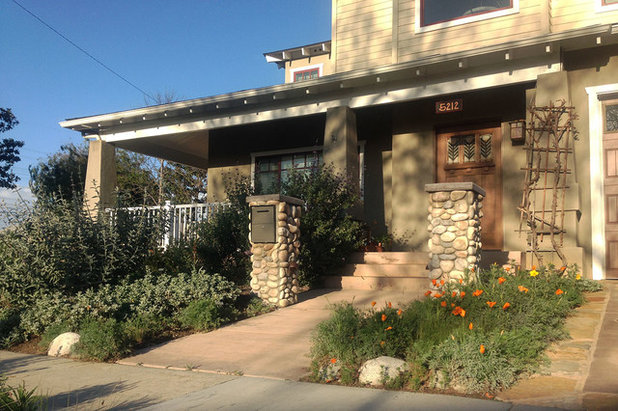
Theodore Payne Foundation
9. Relaxed Restoration Garden Location: Torrance, California
Size: 700 square feet (65 square meters)
Designer: Homeowner Andrew Chaves
Andrew Chaves’ time spent working with the LA Conservation Corps to restore the natural habitat of coastal bluffs inspired his coastal front garden’s original design. “I kind of wanted to do the same thing,” he says. He planted seeds that had been collected locally and that attract rare local wildlife, including seacliff buckwheat (
Eriogonum parvifolium), which the endangered El Segundo butterfly uses as a food source.
Plants shown: Coastal California poppy (
Eschscholzia californica var.
maritima), ‘Vicki Romo’ sage (
Salvia ‘Vicki Romo’), common sandaster (
Corethrogyne filaginifolia)
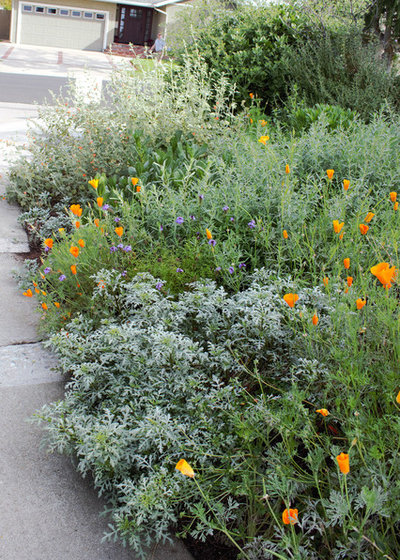
Theodore Payne Foundation
Now Chaves works as the manager of operations
at the Theodore Payne Foundation and through the foundation has come to appreciate native plants for their aesthetic qualities in addition to their environmental benefits. He has planted beneficial California natives from a wider region as well as native cultivars, which are native plants that have been cultivated for specific traits and are still considered beneficial. “All still provide food and habitat,” he says.
See more photos and this garden’s complete plant list
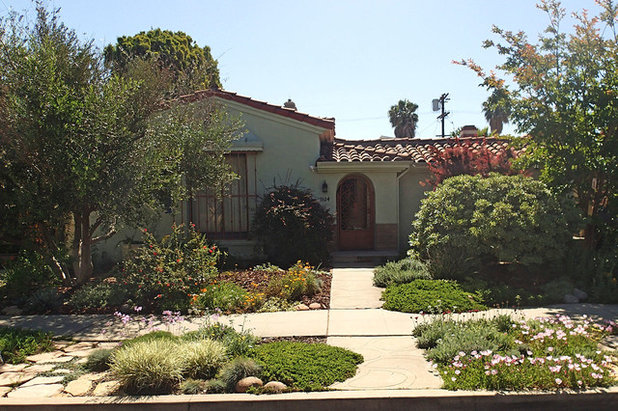
Theodore Payne Foundation
10. An Evolving Front GardenLocation: South Carthay neighborhood of Los Angeles
Size: 900 square feet (83.6 square meters)
Designer: Homeowner Beverly Crist
Beverly Crist’s cottage-style front garden has been evolving since she moved in a decade ago. After replacing the front lawn, rosebushes and manicured shrubs — thirsty plants that were “too traditional and predictable” for Crist, she says — she filled her garden with attractive low-water plants from the Mediterranean region, including an olive tree, lavenders and sages, which grow well in California.
Plant shown: Baja fairy duster (
Calliandra californica)
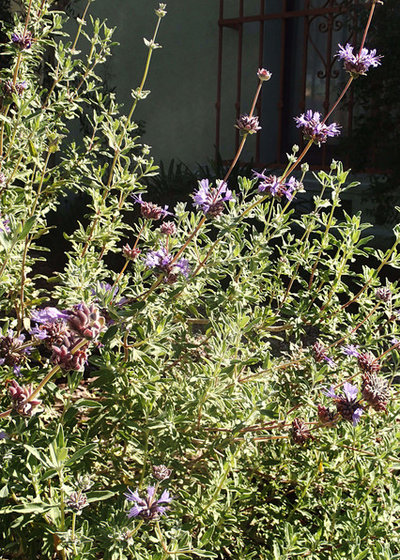
Theodore Payne Foundation
Crist discovered native plants after she had planted her Mediterranean garden. Over time she has replaced the plants that have died with native alternatives — planting California sages where there had been Mexican sage, for instance. While an olive tree still graces the front yard and Mexican evening primrose cascades from the parking strip into the street, roughly 70 percent of her plants are now native.
Plant shown: Cleveland sage (
Salvia clevelandii cv.)
See more photos and this garden’s complete plant list





